
Grits are a type of porridge made from coarsely ground dried maize or hominy, the latter being maize that has been treated with an alkali in a process called nixtamalization, with the pericarp removed. Grits are cooked in warm salted water or milk. They are often served with flavorings as a breakfast dish. Grits can be savory or sweet, with savory seasonings being more common. Grits are similar to other thick maize-based porridges from around the world, such as polenta and mieliepap. The dish originated in the Southern United States but is now available nationwide. Grits are often part of a dinner entrée shrimp and grits, served primarily in the South USA.

Porridge is a food made by heating or boiling ground, crushed or chopped starchy plants, typically grain, in milk or water. It is often cooked or served with added flavourings such as sugar, honey, fruit, or syrup to make a sweet cereal, or it can be mixed with spices, meat, or vegetables to make a savoury dish. It is usually served hot in a bowl, depending on its consistency. Oat porridge, or oatmeal, is one of the most common types of porridge. Gruel is a thinner version of porridge and congee is a savoury variation of porridge of Asian origin.

Cornmeal is a meal ground from dried corn (maize). It is a common staple food and is ground to coarse, medium, and fine consistencies, but it is not as fine as wheat flour can be. In Mexico, very finely ground cornmeal is referred to as corn flour. When fine cornmeal is made from maize that has been soaked in an alkaline solution, e.g., limewater, it is called masa harina, which is used for making arepas, tamales, and tortillas. Boiled cornmeal is called polenta in Italy and is also a traditional dish and bread substitute in Romania.
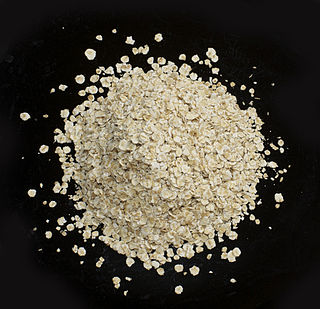
Oatmeal is a preparation of oats that have been de-husked, steamed, and flattened, or a coarse flour of hulled oat grains (groats) that have either been milled (ground), rolled, or steel-cut. Ground oats are also called white oats. Steel-cut oats are known as coarse oatmeal, Irish oatmeal, or pinhead oats. Rolled oats were traditionally thick old-fashioned oats, but can be made thinner or smaller, and may be categorized as quick oatmeal or instant oatmeal depending on the cooking time required, which is determined by the size of the oats and the amount of precooking.

Cornbread is a quick bread made with cornmeal, associated with the cuisine of the Southern United States, with origins in Native American cuisine. It is an example of batter bread. Dumplings and pancakes made with finely ground cornmeal are staple foods of the Hopi people in Arizona. The Hidatsa people of the Upper Midwest call baked cornbread naktsi. Cherokee and Seneca tribes enrich the basic batter, adding chestnuts, sunflower seeds, apples, or berries, and sometimes combine it with beans or potatoes. Modern versions of cornbread are usually leavened by baking powder.
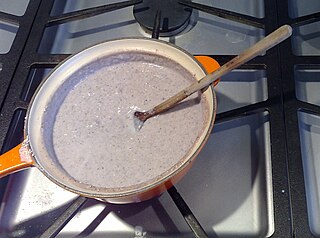
Atole, also known as atolli, atol and atol de elote, is a traditional hot masa-based beverage of Mexican origin. Atole can have different flavors added such as vanilla, cinnamon, and guava. Chocolate atole is known as champurrado or simply atole. It typically accompanies tamales and is very popular during Day of the Dead and Las Posadas.

Pease pudding, also known as pease porridge, is a savoury pudding dish made of boiled legumes, typically split yellow peas, with water, salt and spices, and often cooked with a bacon or ham joint. A common dish in the north-east of England, it is consumed to a lesser extent in the rest of Britain. In Newfoundland, it retains its traditional name as part of the customary Jiggs dinner. In non-English speaking countries, similar dishes exist under different names.

The Art of Cookery Made Plain and Easy is a cookbook by Hannah Glasse (1708–1770), first published in 1747. It was a bestseller for a century after its first publication, dominating the English-speaking market and making Glasse one of the most famous cookbook authors of her time. The book ran through at least 40 editions, many of which were copied without explicit author consent. It was published in Dublin from 1748, and in America from 1805.
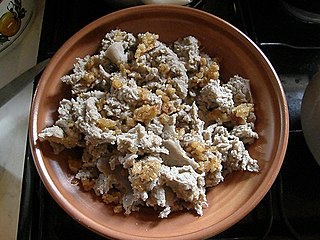
Žganci is a dish in Slovenian and Croatian cuisine, also called pura on the Croatian coast. It is a traditional "poor man's food" of hard-working farmhands similar to polenta, although prepared with finer grains.

Spoonbread is a moist cornmeal-based dish prevalent in parts of the Southern United States. While the basic recipe involves the same core ingredients as cornbread – namely cornmeal, milk, butter, and eggs – the mode of preparation creates a final product with a soft, rather than crumbly, texture. As the name implies, the consistency is soft enough that it needs to be served and eaten with a spoon.

Scottish cuisine encompasses the cooking styles, traditions and recipes associated with Scotland. It has distinctive attributes and recipes of its own, but also shares much with other British and wider European cuisine as a result of local, regional, and continental influences—both ancient and modern.
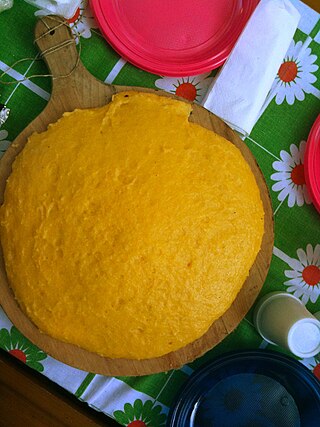
Mush is a type of cornmeal pudding which is usually boiled in water or milk. It is often allowed to set, or gel into a semisolid, then cut into flat squares or rectangles, and pan fried. Usage is especially common in the eastern and southeastern United States. It is customary in the midwestern United States to eat it with maple syrup or molasses. In Eastern Europe, milk is poured over the meal once served and cooled down, rather than being boiled in it. Cornmeal mush is often consumed in Latin America and Africa.

Dominican cuisine is made up of Spanish, indigenous Taíno, Middle Eastern, African, Cuban, Puerto Rican and Haitian influences. The most recent influences in Dominican cuisine are from the British West Indies and China.
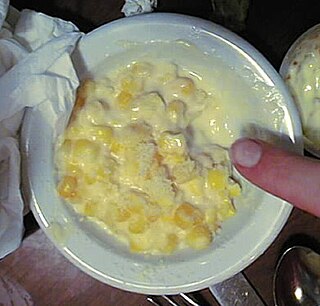
Corn pudding is a creamy dish prepared from stewed corn, water, any of various thickening agents, and optional additional flavoring or texturing ingredients. It is typically used as a food staple in rural communities in the Southern United States, especially in Appalachia.

The cuisine of the Thirteen Colonies includes the foods, bread, eating habits, and cooking methods of the Colonial United States.

Mazamorra or masamorra is the name for numerous traditional dishes from the Iberian Peninsula and Hispanic America.
Almond pudding is a milk pudding or custard thickened with ground almonds and sometimes flavored with almond extract. There are versions of almond pudding found in the Arab cuisines of the Middle East, and variations of this dish are found in American, European, Turkish, Persian, Indian, Chinese, and other world cuisines.

Corn stew is a stew prepared with corn (maize) as a primary ingredient. Many variations exist in ingredient usage and in methods of preparation. Corn stew is a dish in several cuisines of the world. Mazamorra is a historically old corn stew dish in South America that is prepared using simple ingredients, and is a dish in several other cuisines.
















